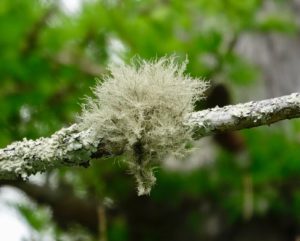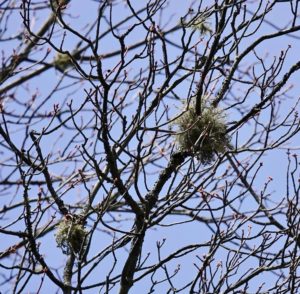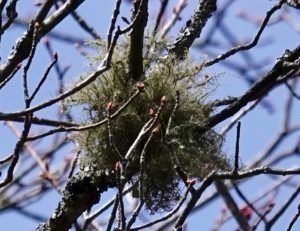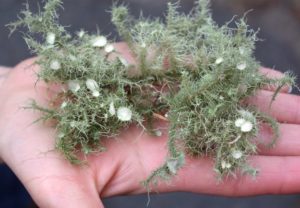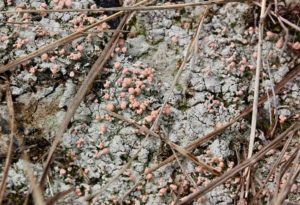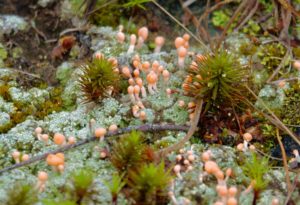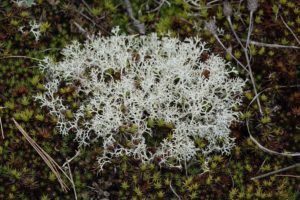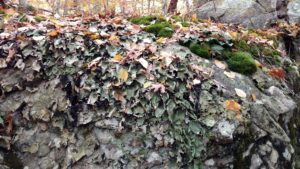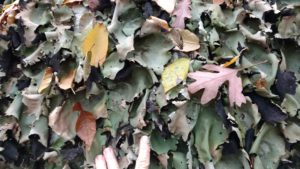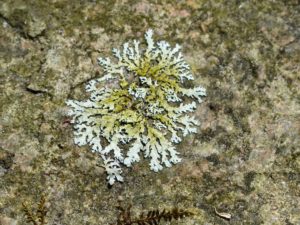Sightings – Lichen
Observer: Paul Lauenstein
Observation Date: 4/25/23
Observation Time: 1:27 p.m.
Observation Location: Gavins Pond Rd. (my back yard)
Common Name: Beard lichen
Scientific Name: Usnea strigosa
Comments: Also called bushy beard, this epiphytic (i.e. growing on trees) lichen is a composite organism that emerges from algae or cyanobacteria living among the filaments of the fungi in a symbiotic (mutually beneficial) relationship. The fungi benefit from the carbohydrates produced by the algae or cyanobacteria via photosynthesis. The algae or cyanobacteria benefit by being protected from the environment by the filaments of the fungi, which also gather moisture and nutrients from the environment, and (usually) provide an anchor to it.
More Information: Wisconsin Dept. of Natural Resources
Observer: Paul Lauenstein
Observation Date: 12/4/09
Observation Time: 3:30 p.m.
Observation Location: Gavins Pond Road opposite soccer fields
Common Name: British Soldier Lichen
Scientific Name: Cladonia cristatella
More Information: Backyard Nature: Lichen
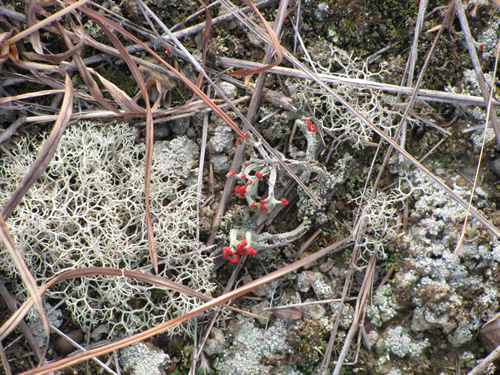
Compare the British soldier lichen to the pink earth lichen below. These photos were taken at about the same time, and in the same area.
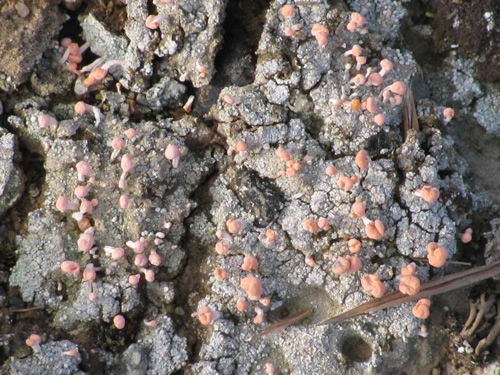
Observer: Paul Lauenstein
Observation Date: 7/17/10
Observation Time: 9:10 a.m.
Observation Location: near Gavins Pond
Common Name: Common Greenshield Lichen
Scientific Name: Flavoparmelia caperata
More Information: Wikipedia
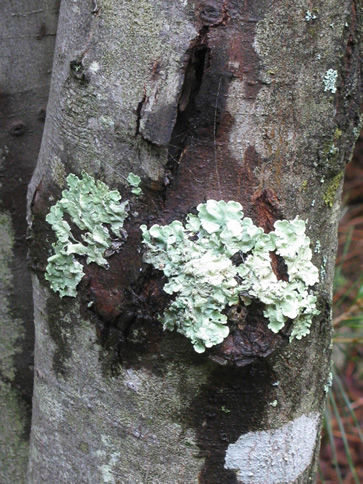
Observer: Paul Lauenstein
Observation Date: 4/16/20
Observation Time: 1:45 p.m.
Observation Location: conservation land at Lakeview & Morse
Common Name: Old Man’s Beard lichen
Scientific Name: Usnea strigosa
Comments: Also called bushy beard, this epiphytic (i.e. growing on trees) lichen is a composite organism that emerges from algae or cyanobacteria living among the filaments of the fungi in a symbiotic (mutually beneficial) relationship. The fungi benefit from the carbohydrates produced by the algae or cyanobacteria via photosynthesis. The algae or cyanobacteria benefit by being protected from the environment by the filaments of the fungi, which also gather moisture and nutrients from the environment, and (usually) provide an anchor to it.
More Information: Wisconsin Dept. of Natural Resources
My friend Tom Palmer of Milton helped me identify this lichen, and provided this photo of some he found on the ground at Moose Hill Farm in Sharon on 5/4/18.
Observer: Paul Lauenstein
Observation Date: 5/11/20
Observation Time: 9:40 a.m.
Observation Location: near Gavins Pond
Common Name: Pink earth lichen
Scientific Name: Dibaeis baeomyces
Comments: This lichen is found throughout eastern North America, from Alabama and Georgia in the south to the Arctic Circle in the north. While rare there, it does occur in both Alaska and the Northwest Territories. It prefers to grow directly on unstable soils such as loose sand or dry clay, and in full sun. It also prefers acid soils to neutral or alkaline. On disturbed ground, a preferred habitat type, it is able to spread quickly for a lichen.
More Information: Wikipedia
Observer: Paul Lauenstein
Observation Date: 5/6/24
Observation Time: 8:00 a.m.
Observation Location: Moose Hill Audubon Wildlife Sanctuary
Common Name: Pink Earth lichen
Scientific Name: Dibaeis baeomyces
Comments: It’s been a rainy spring, which might stimulate these colorful lichens.
More Information: Naturally curious with Mary Holland
Observer: Paul Lauenstein
Observation Date: 9/12/09
Observation Time: 11:00 a.m.
Observation Location: near Gavins Pond
Common Name: Pink Earth lichen
Scientific Name: Dibaeis baeomyces
More Information: Naturally Curious with Mary Holland
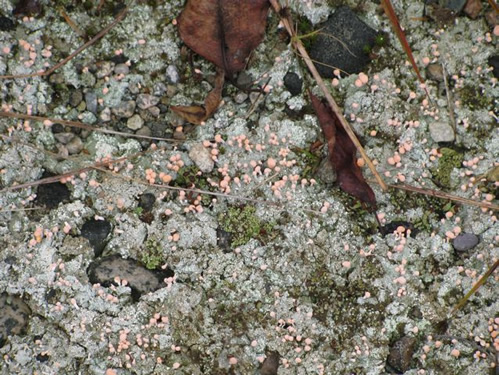
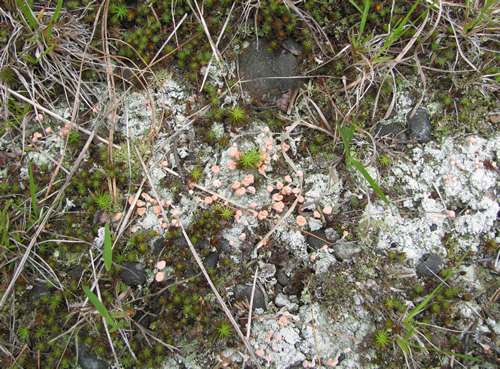
Observer: Paul Lauenstein
Observation Date: 5/18/20
Observation Time: 10:20 a.m.
Observation Location: under high tension lines across the street from the Gavins Pond soccer fields
Common Name: Reindeer lichen
Scientific Name: Cladonia rangiferina
Comments: Reindeer lichen is a light-colored, fruticose lichen belonging to the family Cladoniaceae. It grows in both hot and cold climates in well-drained, open environments. As the common names suggest, reindeer lichen is an important food for reindeer (caribou) and has economic importance as a result. Reindeer lichen, like many lichens, is slow growing (3–11 mm per year) and may take decades to return once overgrazed, burned, trampled, or otherwise consumed.
More Information: Wilipedia
Observer: Kathy Farrell
Observation Date: 10/30/2018
Observation Time: N/A
Observation Location: Mountain Street
Common Name: Rock Tripe lichen
Scientific Name: Umbilicaria mammulata
Comments: This lichen is edible (after boiling several times). It is considered to be “starvation food.” There are stories of George Washington’s troops eating it when they had nothing else. I found it in a rocky cliff area.
More Information: https://www.youtube.com/watch?v=STxqLRmK03c and https://www.adirondackalmanack.com/2010/04/ruminations-on-rock-tripe.html
Observer: Paul Lauenstein
Observation Date: 4/16/19
Observation Time: 12:55 p.m.
Observation Location: Moose Hill Audubon Wildlife Sanctuary
Common Name: Rock-shield Lichen
Scientific Name: Xanthoparmelia sp.
Comments: A lichen is a composite organism that emerges from algae or cyanobacteria living among the filaments of the fungi in a symbiotic (mutually beneficial) relationship. The fungi benefit from the carbohydrates produced by the algae or cyanobacteria via photosynthesis. The algae or cyanobacteria benefit by being protected from the environment by the filaments of the fungi, which also gather moisture and nutrients from the environment, and (usually) provide an anchor to it.
More Information: Project Noah and Wikipedia

